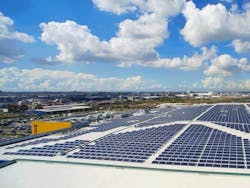Iconic retail giant IKEA is set to help power a microgrid initiative in South Australia. Part of a switch to 100% renewable energy, IKEA will tie in large-scale solar with storage capacity.
IKEA’s Adelaide store will be powered with a 1.2 MW roof-top solar PV installation and 3.4 MWh of electricity storage, but the system will also support a wider microgrid network.
Described by IKEA as Australia’s largest grid-connected commercial microgrid, the project is being developed as part of the IKEA Australia Clean Energy Transformation Project. It is being run in conjunction with Planet Ark Power, the South Australian Government, SA Power Networks and Epic Energy, the owner and operator of the microgrid.
Epic Energy will provide more than 70% of the building’s electricity demand while the rooftop solar panels and an on-site battery manufactured by CATL will be managed by Planet Ark Power’s eleXsys digital energy management system. This will allow excess stored energy to be traded into the South Australian network during peak demand periods when prices are at their highest.
In addition, Schneider Electric’s microgrid management systems and Planet Ark Power’s system allow IKEA to help SA Power Networks to manage the local network. An estimated 310 MWh of stored energy will be exported to the SA Power Network annually.
The first phase of the Clean Energy Transformation Project also will see electric vehicle chargers erected at the site for customers, co-workers and IKEA’s South Australia delivery fleet.
Furthermore, IKEA Adelaide is scheduled to operate entirely on renewable energy by 2025 as part of the second phase, which will include sustainably-sourced timber shade structures across the car park with more PV. Hosting additional solar panels, these structures will generate a further 30% of the store’s energy needs. Not only will IKEA Adelaide become 100% powered by on-site renewables but the second phase will also increase the amount of surplus renewable energy available for sale to the grid.
First mover ambition
Looking further ahead, IKEA is planning to investigate the viability of using excess solar to generate hydrogen on site, as well as the possibility for IKEA to become an energy provider that can create and sell renewable energy to the energy network.
“Our ambition is to be the first mover and inspire other IKEA stores to install larger solar installations, batteries and digital solutions,” said Jan Gardberg, CEO and chief sustainability officer of IKEA Australia.
Funding for the project came in part from a $1.36 million grant from the South Australian Government’s Renewable Technology Fund.
Join us at Microgrid 2020 Global on November 17 for a special virtual session, “Global Drivers for Microgrids.” The event is free but space is limited on the platform, so please register soon to secure your access.
The latest renewable energy development from the franchise group follows the launch of its sustainability strategy, People & Planet Positive, in 2012. Under the terms of the strategy, by 2030 the IKEA business will become climate positive — reducing more greenhouse gas emissions than the entire value chain emits — and enable people to generate renewable energy and be energy and water efficient.
For example, since 2009 the Ingka Group, which owns IKEA franchises across 30 countries, has invested close to $2.9 billion in on- and offsite renewables as part of this 2030 goal and aims to consume 100% renewable electricity in its retail operations by 2025. In September, Ingka announced that it plans to invest a further $691 million in renewables this year alone. Ingka already owns and operates more than 920,000 on-site solar modules. The addition of electricity storage is expected to boost opportunities to generate revenue from its renewable energy investments.
IKEA creates prototype microgrid
IKEA also has launched a home solar business in five key markets and has also developed a microgrid model through its Space 10 innovation laboratory. The new prototype, called SolarVille, features a blockchain-powered platform that would allow the direct trade of excess solar power between microgrid participants.
Track news about microgrids worldwide. Subscribe to the free Microgrid Knowledge newsletter.







